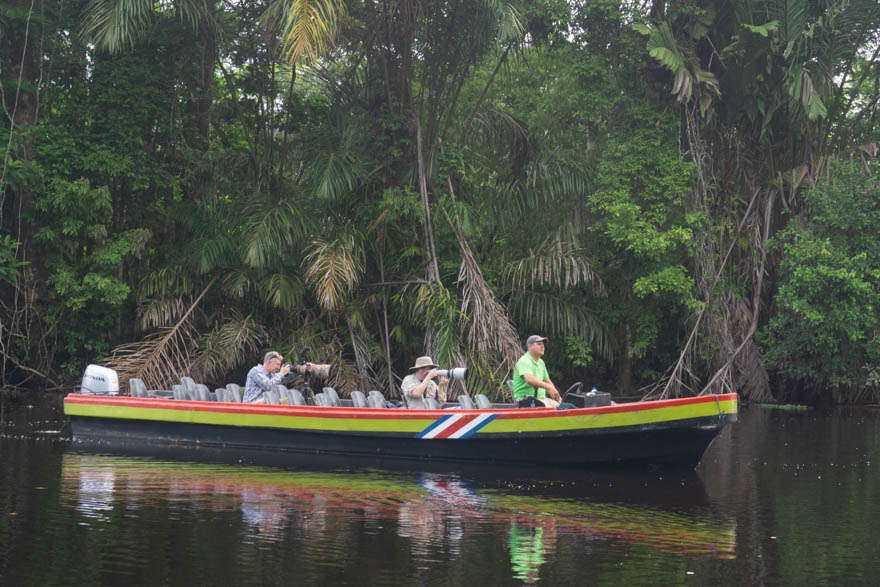We wanted to share our newest travel photography workshop based in Costa Rica.
Day 1 : Arrival
The start of our Costa Rica Photography Workshop. We landed in San Jose, Costa Rica in the evening after a very pleasant flight. At the airport, we were greeted by my local contacts and then quickly whisked off to the Sarapiqui River region. Located just north of the Braulio Carrillo National Park, the Sarapiqui is a hub for rafters and outdoor enthusiasts with class 3 -4 rapids and plenty of great hiking.
We arrived at our fantastic hotel and celebrated our arrival with a cold beer on the deck immersed in the Costa Rican forest. Our hotel is nested nicely at the convergence of the Sarapiqui and Puerto Viejo Rivers, where they crafted the layout of the resort with the contours of the property.
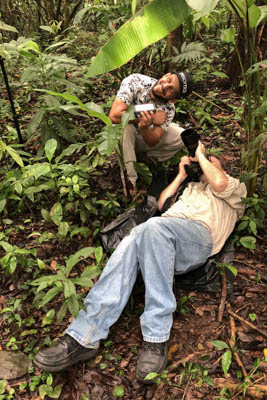
Honduran white bats nested up in the under side of a leaf
We are checking all the camera gear, as frog photography is tomorrow!
Day 2 : The Frogs
After a traditional Costa Rican breakfast, we headed out early to our first location to photograph frogs. The family-owned property is farm acreage converted into a habitat for frogs! They have been providing a sanctuary for a diversity of frogs to flourish for nearly a decade now. With that, more birds and even sloths have begun to move into the area. This is prime wildlife and nature photography!
Today our focus is on getting those great frog pictures, still leaving our eyes and lenses open for other opportunities in this tropical forest. Costa Rica photography workshops always have an interest in the frog life of this tropical nation.
We got some great shots of,
- Red-eyed tree frogs
- Green and black poison dart frogs
- Strawberry poison dart frogs, including the Blue Jeans morph of this species
- Masked Tree frogs
- Glass frogs
Working hard all morning on some rather unique shots of the frogs we gather with the property owner and enjoy a fantastic home cooked lunch prepared by his wonderful mother!
We must have been inspired by the land and life, as we photographed the whole day.
Off to the resort, and back to the open air restaurant for a nice dinner and a drink on the deck overlooking the lagoon as the birds fly by.
Pura Vida, mi amigo! Pura vida …
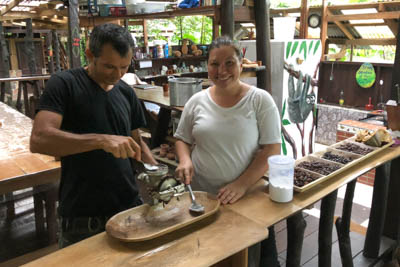
Showing us how to make chocolate and sending us home with the bars!
We launched out to a new location in the Horquetas region of Costa Rica, still buzzing from yesterday and fueled by fresh Costa Rican coffee. Today the destination is a lush ecological garden sanctuary operated by a wonderful husband wife team who are passionate about what they do!
Beginning as a butterfly-based business, they soon realized that working the land for butterflies brought in a richer diversity of wildlife. Sloths moved in, bats and birds took up residences, and the owners cultivated plants, especially Cocoa!
After a very charming and informative personal tour by the owners, we set off on our own to photograph. By the way, the owners are extremely knowledgeable about the land, nature, culture, and ecology of their intended sanctuary. I heard more actual Latin spoken through scientific naming of all the species on that tour than in all of my life!
That wet our appetites to shoot and we all took mental notes of where to find what, which was great. We were so honored to photograph these nature images:
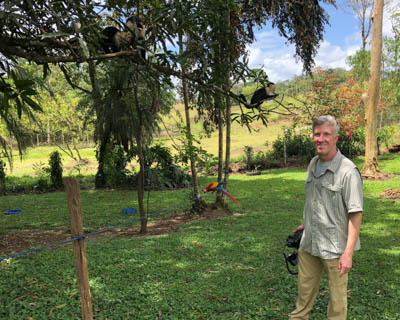
Matt hanging out with the monkeys
- Euphonia birds nesting
- White collared manakin overlooking her chick
- Helmet Headed (or Casque headed) lizards
- Blue Morpho Butterflies
- Owl butterflies with their famously huge eye spots
- Long-billed hermit hummingbird chicks nesting
- Honduran white bats or Caribbean white tent-making bats
- Red-eyed tree frogs
- Blue jean frogs
- Green Emerald Basilisk Lizards, also called the Jesus Christ lizard because it walks on water
- Iguanas
- Spectacled caiman or common caiman
- Blue-gray tanagers
- American Pygmy Kingfishers
- Long-tailed tyrants
- Passerini’s Tanagers
We enjoyed a wonderful midday meal with fresh tropical juices prepared by “Mama,” the local chef de cuisine! Then off for more photographing. After another full day of shooting, the owners had a nice surprise waiting for us.
From those cocoa plants they showed us earlier, the owners not only explained how they make chocolate from it, but they created it right in front of us! We definitely delighted in these bittersweet treats and they paired it with fresh coffee. To top it off, they sent some home with us candy bar-style made from the dried seeds! Souvenirs for our families from this Costa Rica photography workshop!
The combination of the beautiful butterfly and frog gardens with our gracious and hospitable hosts made for a wonderfully memorable day.
Back to the hotel for another hearty meal, relaxing on the deck, and sleeping deeply with the sounds of the forest.
Learn more about our Photography Workshop here.
Day 4 : Colorful Macaws and curious monkeys
Today we headed to a local farm where the owner calls to the Macaws and they come to him! To say the least, this offers great opportunities for photos. We were also treated to plenty of White-faced capuchins running around. These are highly social, small-sized monkeys that you have probably seen on TV or in a movie. We saw some cute moments, like young baby monkeys holding tightly on to their mother’s back.
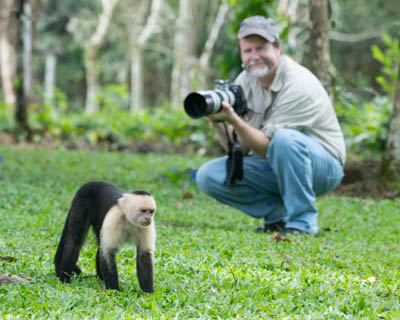
Brian photographing the white-headed capuchin monkeys
Watch out for these curious critters! They will be in your unattended camera pack in a second, or at least mine. These mischievous monkeys are pretty advanced. They have complex social structures, use tools, and are omnivorous. Meaning they will eat everything, including camera equipment if you are not careful 🙂
We got to photograph some brilliantly colorful species,
- Scarlet macaws, or the iconic large red, yellow, blue parrot
- Great green macaws, or Buffon’s macaw
- White-headed capuchin monkeys
- Yellow-naped parrots
- Crimson-fronted parakeet, or Finsch’s conure
Once the action slowed down there, we set off to photograph some hummingbirds and other birds that call Costa Rica home. This particular farm is really a nature center with a premier Colibri (Hummingbird) Garden. Here are some of the species of hummingbirds we saw.
- White-necked jacobin hummingbird (Florisuga mellivora)
- Rufous-tailed hummingbird (Amazilia tzacatl)
- Green-breasted mango hummingbird (Anthracothorax prevostii)
- Bronze-tailed plumeleteer hummingbird (Chalybura urochrysia) also known as the Red-footed plumeleteer hummingbird
- Scaly-breasted hummingbird (Phaeochroa cuvierii)
- Stripe-throated hermit hummingbird (Phaethornis striigularis)
We took A LOT of pictures! With memory cards full, and batteries needing power, we headed to our hotel for the night. With a full day tomorrow, we enjoyed another freshly prepared Costa Rican meal and tropical-style relaxing on the deck.
Day 5 – 7 : Days of Birds, Bats, and Vipers
Waking up, we grabbed our gear and left the hotel very early to photograph the Macaws. Before venturing too far, we stopped over at a local’s breakfast place and enjoyed a really tasty breakfast to strengthen us for the journey.
We then headed north to a rainforest lodge where we will spend the next few days. This retreat is located on 1250 acres of unspoiled tropical land near Boca Tapada and the Rio San Carlos. With over 6 miles, or 10 km, of nature trails, it makes for accessible birdwatching and easy exploration of the ancient forest. So far, they have counted over 350 bird species on the property!
When we arrive, we are told about a Motmot and Pygmy owl that are in the trees just nearby. What a perfect welcome to our new studio! We grabbed our cameras and photographed them for a bit. Our real goal was to get in a night photography session for bat feeding pictures. Targeting the Long-tongued bats which feed on the nectar of flowers, we prepped our multi-flash setups.
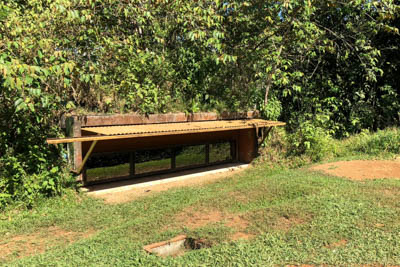
The vulture blind
Over the next few days of this Costa Rica photography workshop, we captured the following images:
- Blue-gray tanagers
- Broad-billed motmot
- Mexican Long-tongued bats
- Central American pygmy owl
- Black-mandibled toucan, or Yellow-throated toucan
- Brown-hooded parrot
- Black-cowled oriole
- Great curassow, a big 3′ tall black bird
- Passerini’s tanager
- Montezuma oropendola
- Red-legged honeycreeper
- Golden-hooded tanager
- Palm tanager
- Chestnut-colored woodpecker
- Black-crowned tityra
- White-nosed coati, or coatimundi
- Central American Agouti
- Eyelash palm pit viper
We developed a nice routine while at the lodge. In the mornings, we would photograph the birds off the deck while sipping on fresh coffee. Then we would head over to the vulture blind to photograph:
- King vulture
- Black vulture
- Turkey vulture
Coming back for a short break to fuel up. We would enjoy a relaxing lunch on the deck overlooking a lagoon with birds all around. It was almost like having a meal together!
One day we photographed three Eyelash vipers and a Pygmy owl catching a lizard. That was such an exciting scene to capture! Watching them work together to quarry the prey, then fight for the reward.
In the afternoons, we would photograph more birds, of course! (That is actually the main subject focus on this particular Costa Rica photography workshop.) As the sun would set, we would setup our unique multi-flash system for more nocturnal bat photography.
Day 8 : Costa Rica’s Amazon Jungle
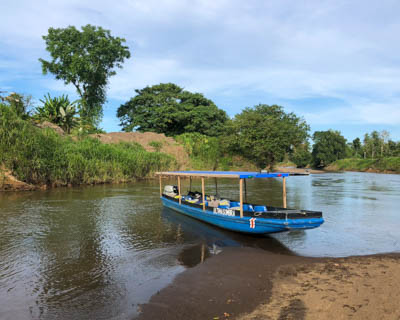
Our transportation for the next 3 days going to Tortuguero National Park
We departed from the beautiful lodge early as we headed toward Tortuguero National Park in the Limon province of Costa Rica. Some say Tortuguero means to “turtle catcher,” while others say its simply refers to the “region of the turtle.” Either way, this rich ecological hub is a playground for sea turtles and a sundry of wildlife.
In fact, the park is formed from where the sea meets freshwater along the Caribbean coast with an archipelago of volcanic islands. It is often referred to as Costa Rica’s “Amazon Jungle” thanks to the extensive waterway systems and marshy islands where boat is the best way to get around.
As a prolific nature refuge, the park totals nearly 47, 000 acres of 11 different habitats, 22 miles of sandy beach, and a range in elevation from 0 to 1,280 feet! Trust me when I say, this park is a marvel!
We stopped at the base of Braulio Carrillo National Park on our way to Tortuguero National Park for one main reason, almost half of the bird species found in Costa Rica’s can be found in this region. That is over 400 species of bird plus over 5,000 species of plants!
These tropical wetlands created by the convergence of two great rivers, the Sarapiqui and Puerto Viejo, is home to a fantastic artist-designed birdwatching destination. With hides creatively placed to allow for the best lighting conditions and perspective while overlooking a small pond and rainforest gardens with feeders.
What we found here was a miniature Garden of Eden-like nature sanctuary full of birds, lizards, and even a sloth! We had a wonderful time in the forest photographing Spectacled and Crested Owls, and other incredible wildlife.
- Spectacled owl
- Crested owl
- Glass frog, including the Ghost eye species
- Yellow-bellied stream frog
- 3 Toed Sloth
One of the highlights was the native sloth that put on a great show for us! All at eye level! We photographed this amazing animal as it went from branch to branch, climbing effortlessly and slowly, offering us many different compositions. Sloths also have this smile-like expression on their faces nearly all the time which makes for some great wildlife photography. We had a blast during this one!
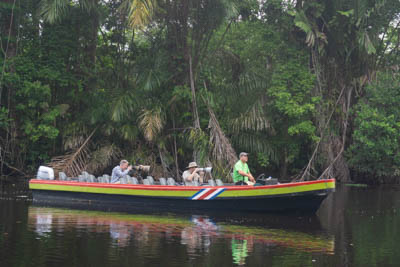
Big boats, and small groups lead to the best results
What I love about all these locations is the hospitality of the owners and the home cooking. We had another scrumptious meal, and then continued on our journey to Tortuguero National Park.
Car parked. Check. Now to meet with our captain. We are moving about by boat, winding through the canals. For an hour, we sit awed by the towering forests until we arrived at our hotel, this place is amazing!
By building with the landscape and adapting the hotel to the natural environment, we get to experience the rainforest in its perrenifolio state,”always green.”
We arrived just in time for a lovely dinner with exotic drinks and a relaxing night. Simply perfect after a full day of photography!
Day 9 and 10 : Jungle Life
As we continue to explore Tortuguero National Park and its wildlife filled canals, we are treated with private boat excursions in the mornings and afternoons. We enjoy a large boat with lots of room for our gear. As we looked around, others had 20+ people in a boat, and we have just 4 in the same size! Small group photography trip certainly lead to better images.
Along the extensive network of lagoons and marshes, you can spot monkeys, birds, and maybe even the rare West Indian manatee. There are sandy beaches where sea turtles nest, tropical lowland rainforest, mangrove forests, swamps, estuaries, wetlands, a labyrinth of rivers, and more all found in the park.
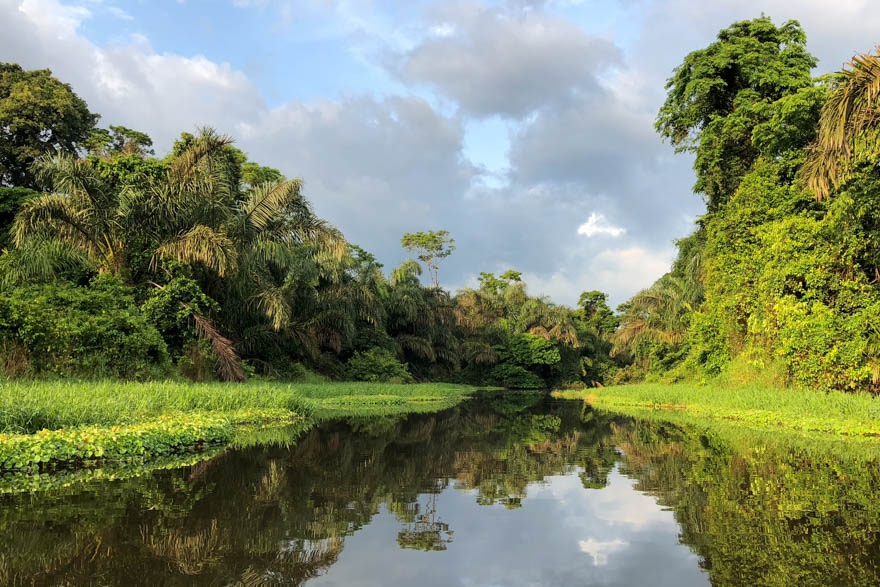
Stunning Tortuguero National Park
What we really appreciated was the heavy focus on conservation in the park. For the wetlands and wildlife, Tortuguero National Park is an enormous biological refuge!
As we explored the different canals and saw what opportunities there were, here is some of what we photographed:
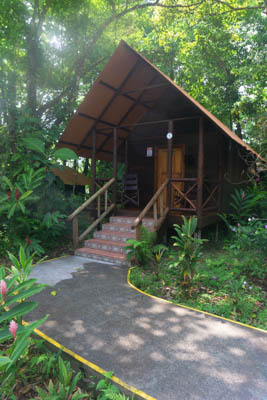
Comfortable Cabañas
- White-faced capuchin monkey
- Howler monkeys
- Spider monkeys (eating heart of a palm tree)
- Spectacled caiman
- Green basilisk lizard
- Green Iguana
- Red-webbed tree frog
- Blue Jeans morph of Strawberry poison-dart frog
- Neotropical otter, or the rare Central American river otter
- Lesser long-nosed bats
- Slaty-tailed trogon
- Snowy egret
- Greater potoo
- Bare-throated tiger heron
- Sunbird on nest
- American Pygmy kingfisher
- Amazon kingfisher
- Mangrove swallow
- Anhinga, or Snakebird, or American darter
- Green heron
- Northern jacana
- Keel-billed toucan
- Black-throated trogon with insect
- Sunbittern
- Ringed kingfisher
- Purple gallinule
- Mealy parrot
- Little blue heron
- Green ibis, or Cayenne ibis
- Yellow-crowned night heron
- Great kiskadee
- Red-lored amazon in a tree nest
- Passerini’s tanager
- Montezuma oropendola
- Double-toothed kite
- Tiny hawk
- Black-mandibled toucan
During midday, when not exploring the canals by boat, we would take the opportunity to photograph in the many setups on the property. Our favorite subject was definitely the Red-webbed tree frog and the Blue jeans frog morph.
The Strawberry poison-dart frog is aptly named, being of reddish skin with black freckles. The Blue jeans color morph is when the legs of this frog species turn a bluish color. The various stages and metamorphosis of frogs and amphibians is fascinating!
Day 11 : Every Last Drop
Woke early, still piqued from the whole trip. With it coming to an end, we headed out before sunrise for another photo shoot on the boat. We photographed a lot of tiger herons, and then came across some howler monkeys and spider monkeys that really put on a show for us.
These are relatively small primates, but howler monkeys have a vocalization that you can feel in your bones!
We get photographing all the way until we had to check out of this breathtaking hotel. We took the boat back on the scenic route up the river to our car. Once back to the roads, we made moves back to San Jose and said our goodbyes.
I feel so honored to be part of leading trips to Costa Rica. I know the photos and memories will last for a long time to come.
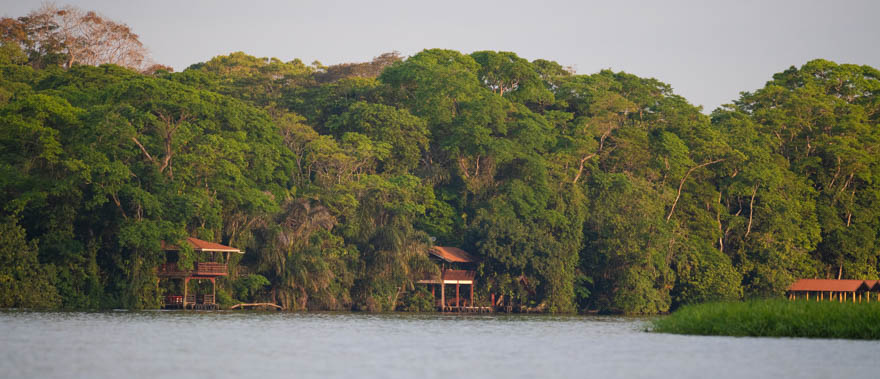
The boat dock at our Tortuguero National Park hotel

